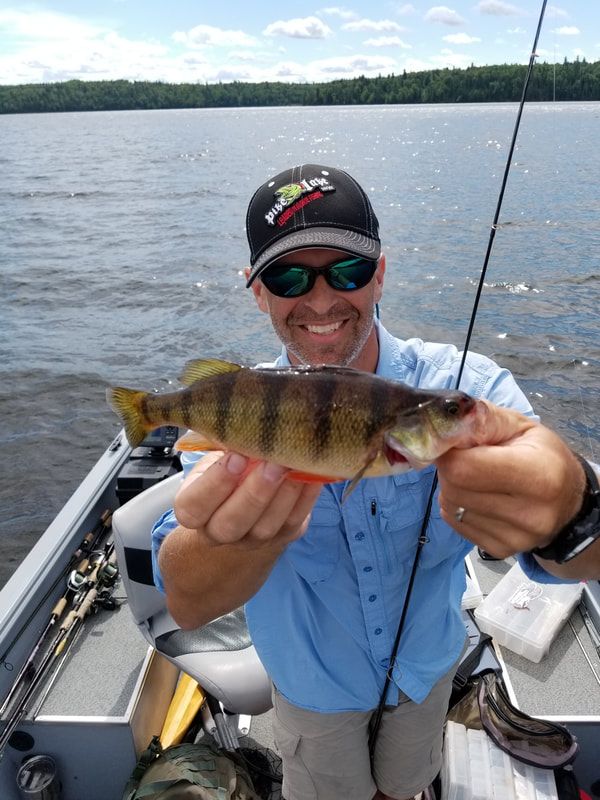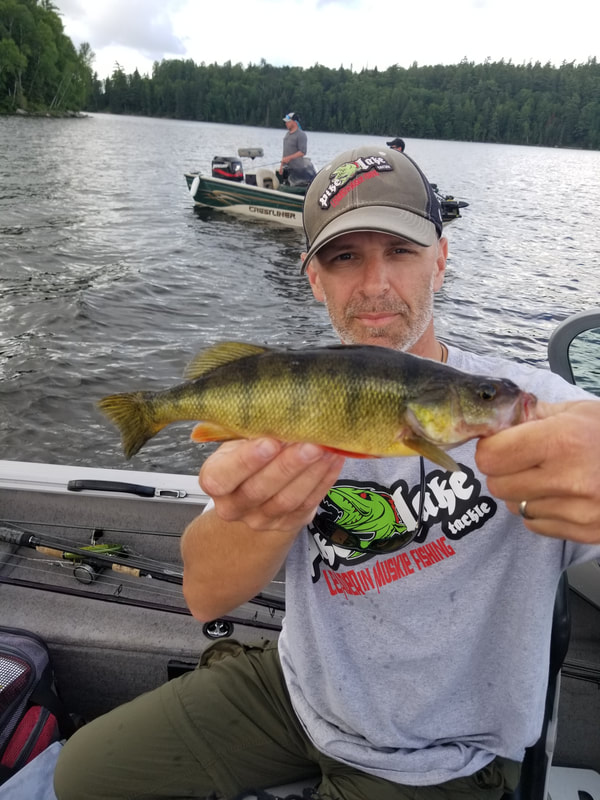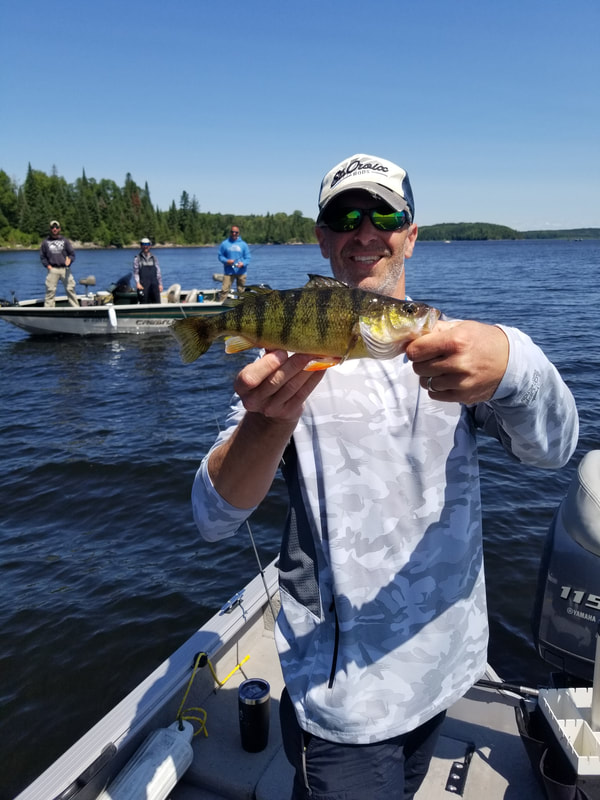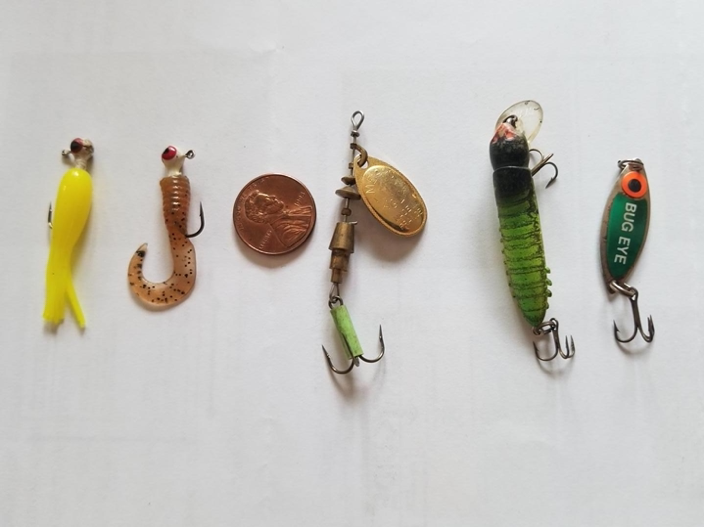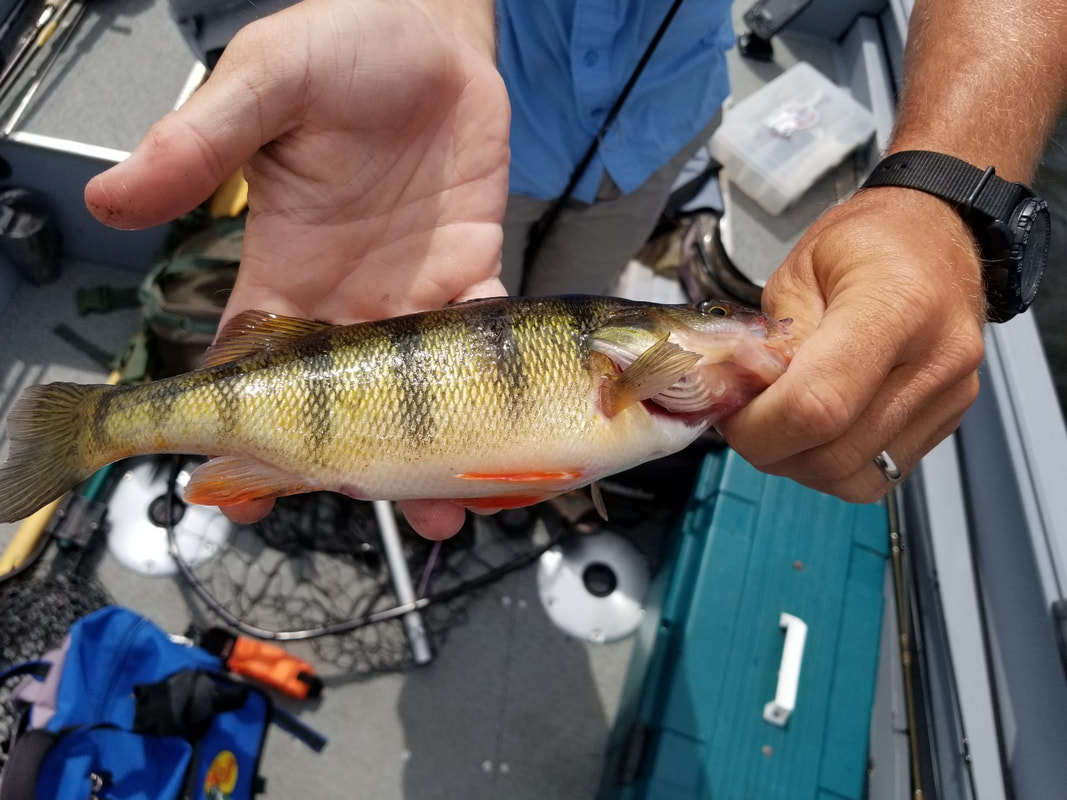Yellow Perch
Perca flavescens
HOME
Other Species
Contributed by guest author Gary Nichols
Yellow Perch Description
Generally classified as a panfish, yellow perch are related to the walleye, but do not get nearly as large. An average perch is about 6”- 7” in length with 12" considered a trophy in most waters. They are gold in color with white bellies and vertical stripes running from their backs down their sides. They have a sharp, spiny dorsal fin that is extended when they feel threatened.
Perch feed on invertebrates, insects, minnows (including their own), and small crustaceans. They are also an important forage species for game fish in many waters. Yellow perch are one of the most widely distributed fish in North America. They are naturally found along the east coast from Nova Scotia to South Carolina and West through most of the US and Canada. They have been introduced to some parts of California, Oregon, and Washington and some southern reservoirs. Part of the reason they are so common is that perch can survive in a wide range of water conditions and are more tolerant of low oxygen levels than some other species. They can be found in shallow weedy areas to deep, clear lakes and anything in between. They are a great target for teaching kids to fish. They are easily found and are very greedy and competitive when schooled up making for fast action.
Perch are not just targeted by kids however. They have a large following because they are great table fare. I can’t think of a fish that tastes better.
Perca flavescens
HOME
Other Species
Contributed by guest author Gary Nichols
Yellow Perch Description
Generally classified as a panfish, yellow perch are related to the walleye, but do not get nearly as large. An average perch is about 6”- 7” in length with 12" considered a trophy in most waters. They are gold in color with white bellies and vertical stripes running from their backs down their sides. They have a sharp, spiny dorsal fin that is extended when they feel threatened.
Perch feed on invertebrates, insects, minnows (including their own), and small crustaceans. They are also an important forage species for game fish in many waters. Yellow perch are one of the most widely distributed fish in North America. They are naturally found along the east coast from Nova Scotia to South Carolina and West through most of the US and Canada. They have been introduced to some parts of California, Oregon, and Washington and some southern reservoirs. Part of the reason they are so common is that perch can survive in a wide range of water conditions and are more tolerant of low oxygen levels than some other species. They can be found in shallow weedy areas to deep, clear lakes and anything in between. They are a great target for teaching kids to fish. They are easily found and are very greedy and competitive when schooled up making for fast action.
Perch are not just targeted by kids however. They have a large following because they are great table fare. I can’t think of a fish that tastes better.
Yellow Perch Tackle
Nothing particularly fancy or specialized is needed to catch perch. An ultralight spinning rod will do the trick in most situations. If you plan to be casting, a longer rod will often help get light weight baits out further. Pair the rod with a small spinning reel (1000 -1500 size) with 4-6 lb monofilament line. 2lb line will handle any perch you are going to encounter, but I usually use 6 lb line simply because there are generally other species such as trout, bass, northern pike, or walleyes in the areas I would be perch fishing. The slightly heavier 6lb line gives you a better chance of landing the other species. Unless you are fishing very deep, or with very light tackle, the slightly heavier line is not that detrimental to your ability to cast or detect bites. Leaders are not necessary unless you are using braided line. In that case I would recommend a short monofilament or Fluorocarbon leader for less visibility in clear water.
Nothing particularly fancy or specialized is needed to catch perch. An ultralight spinning rod will do the trick in most situations. If you plan to be casting, a longer rod will often help get light weight baits out further. Pair the rod with a small spinning reel (1000 -1500 size) with 4-6 lb monofilament line. 2lb line will handle any perch you are going to encounter, but I usually use 6 lb line simply because there are generally other species such as trout, bass, northern pike, or walleyes in the areas I would be perch fishing. The slightly heavier 6lb line gives you a better chance of landing the other species. Unless you are fishing very deep, or with very light tackle, the slightly heavier line is not that detrimental to your ability to cast or detect bites. Leaders are not necessary unless you are using braided line. In that case I would recommend a short monofilament or Fluorocarbon leader for less visibility in clear water.
Yellow Perch Techniques
There are numerous methods for catching Yellow Perch. They are a favorite ice fishing target in the northern United States. In open water they can be caught vertical jigging bait or plastics, casting and slowly bouncing jigs along the bottom, retrieving small crankbaits or spinners near the bottom, or with bait under a bobber. For deeper water, I would suggest a slip bobber that allows you to adjust the depth as needed and makes casting more manageable. For shallow water a set float is fine. The key for all these methods is to stay near the bottom. Perch feed near the bottom, and even when inactive typically stay deep. If you are more than about 6 inches off the bottom you are probably too shallow most of the time.
Yellow Perch Lures
My favorite rig for targeting Perch is a 1/32oz jig head tipped with a small plastic like a glow worm, grub, or 1" Berkeley power tube. Where legal, I will tie a tandem rig by having 12-18" of monofilament with a jig tied to each end. I'll then make a loop slightly off center of that line and attach the loop to the main line. This lets you try a couple different plastics or colors at the same time. You can switch if one type or color is producing more than the other. You can also cast farther due to the added weight. It's not uncommon to catch two Perch on one cast with this system. Cast the jigs out, let them sink to the bottom, and slowly bounce them back to you. Small spoons, spinners, or crankbaits like the Rebel Hellgrammite will also produce. I don't catch as many fish with these as the jigs, but the fish I do catch are generally larger. When fishing deeper water you may want a heavier jig to maintain bottom contact. Using tungsten jigs allows you to keep the small size head, but they are heavier and sink faster than standard leadheads. They are also more expensive but better for the environment.
There are numerous methods for catching Yellow Perch. They are a favorite ice fishing target in the northern United States. In open water they can be caught vertical jigging bait or plastics, casting and slowly bouncing jigs along the bottom, retrieving small crankbaits or spinners near the bottom, or with bait under a bobber. For deeper water, I would suggest a slip bobber that allows you to adjust the depth as needed and makes casting more manageable. For shallow water a set float is fine. The key for all these methods is to stay near the bottom. Perch feed near the bottom, and even when inactive typically stay deep. If you are more than about 6 inches off the bottom you are probably too shallow most of the time.
Yellow Perch Lures
My favorite rig for targeting Perch is a 1/32oz jig head tipped with a small plastic like a glow worm, grub, or 1" Berkeley power tube. Where legal, I will tie a tandem rig by having 12-18" of monofilament with a jig tied to each end. I'll then make a loop slightly off center of that line and attach the loop to the main line. This lets you try a couple different plastics or colors at the same time. You can switch if one type or color is producing more than the other. You can also cast farther due to the added weight. It's not uncommon to catch two Perch on one cast with this system. Cast the jigs out, let them sink to the bottom, and slowly bounce them back to you. Small spoons, spinners, or crankbaits like the Rebel Hellgrammite will also produce. I don't catch as many fish with these as the jigs, but the fish I do catch are generally larger. When fishing deeper water you may want a heavier jig to maintain bottom contact. Using tungsten jigs allows you to keep the small size head, but they are heavier and sink faster than standard leadheads. They are also more expensive but better for the environment.
Yellow Perch Baits
Perch will eat a variety of live or cut bait. Small fathead or shiner minnows, small leeches, wax worms, and earth worms are all good options. Generally speaking, if you are on a school of perch and they are feeding, any of the above will catch fish. It’s still not a bad idea to bring a couple different options as the fish will often show a clear preference to one bait over another. There were many times while fishing the piers along Lake Michigan that I’d be sitting right next to someone else using another bait and one person would be pulling them in one after another while the other only caught a handful in the same time frame. Bait preference can depend on a number of factors such as the local forage and water conditions. In any inland lake I find that perch will quickly maul a piece of night crawler, but I never had any luck using them in the Great Lakes.
At times a piece of cut bait will work very well or even better than live bait. I generally only did this when I had run out of other live bait options and before I really started using plastics. If you have a perch that you have kept you can cut a piece of fillet off and use that. I had better luck using a piece of meat with the skin removed.
My favorite bait for Lake Michigan was a crayfish tail. To do this, remove the tail and squeeze it from the bottom (fin side) up towards the cut like a tube of tooth paste. The meat will slip out without any shell and works really well under a bobber or on a jig. You can get meat from the larger claws as well. Check your local regulations before using crayfish or crayfish parts. Many areas have restrictions due to concerns about invasive species such as rusty crayfish.
With bait you can jig vertically, soak it under a bobber, dead stick it near bottom, cast and retrieve it on a jig, or tip another lure like a spinner with it.
Even when using a bobber I usually use a jig head instead of a plain hook. I find that the fish tend to swallow the bait less frequently with a jig. Even small perch will quickly inhale bait. Lip hooked fish are much more likely to survive after release if you are not keeping them or want to let smaller fish, or trophies for that matter go.
Where to Get Big Yellow Perch
Wisconsin, Minnesota, The Dakotas, Ontario, Manitoba, and Saskatchewan all have plenty of lakes with big perch. The bay of Green Bay, Lake Erie, and Devils Lake in North Dakota all have a reputation for big fish. There are always smaller sleeper lakes with good populations, but these seem to be cyclical. Once word gets out that a perch bite is on, lakes can get overfished quickly. In the North where winterkill occurs due to thick ice and lack of oxygen, the years after winterkill can be great for large perch. This is because the low oxygen levels will often kill off larger predators, but perch will survive. This allows them to grow without depredation for a few years until the other game fish numbers bounce back.
The above barely scratches the surface on how to catch yellow perch. The resources below will provide a wealth of information:
http://www.in-fisherman.com
Perch will eat a variety of live or cut bait. Small fathead or shiner minnows, small leeches, wax worms, and earth worms are all good options. Generally speaking, if you are on a school of perch and they are feeding, any of the above will catch fish. It’s still not a bad idea to bring a couple different options as the fish will often show a clear preference to one bait over another. There were many times while fishing the piers along Lake Michigan that I’d be sitting right next to someone else using another bait and one person would be pulling them in one after another while the other only caught a handful in the same time frame. Bait preference can depend on a number of factors such as the local forage and water conditions. In any inland lake I find that perch will quickly maul a piece of night crawler, but I never had any luck using them in the Great Lakes.
At times a piece of cut bait will work very well or even better than live bait. I generally only did this when I had run out of other live bait options and before I really started using plastics. If you have a perch that you have kept you can cut a piece of fillet off and use that. I had better luck using a piece of meat with the skin removed.
My favorite bait for Lake Michigan was a crayfish tail. To do this, remove the tail and squeeze it from the bottom (fin side) up towards the cut like a tube of tooth paste. The meat will slip out without any shell and works really well under a bobber or on a jig. You can get meat from the larger claws as well. Check your local regulations before using crayfish or crayfish parts. Many areas have restrictions due to concerns about invasive species such as rusty crayfish.
With bait you can jig vertically, soak it under a bobber, dead stick it near bottom, cast and retrieve it on a jig, or tip another lure like a spinner with it.
Even when using a bobber I usually use a jig head instead of a plain hook. I find that the fish tend to swallow the bait less frequently with a jig. Even small perch will quickly inhale bait. Lip hooked fish are much more likely to survive after release if you are not keeping them or want to let smaller fish, or trophies for that matter go.
Where to Get Big Yellow Perch
Wisconsin, Minnesota, The Dakotas, Ontario, Manitoba, and Saskatchewan all have plenty of lakes with big perch. The bay of Green Bay, Lake Erie, and Devils Lake in North Dakota all have a reputation for big fish. There are always smaller sleeper lakes with good populations, but these seem to be cyclical. Once word gets out that a perch bite is on, lakes can get overfished quickly. In the North where winterkill occurs due to thick ice and lack of oxygen, the years after winterkill can be great for large perch. This is because the low oxygen levels will often kill off larger predators, but perch will survive. This allows them to grow without depredation for a few years until the other game fish numbers bounce back.
The above barely scratches the surface on how to catch yellow perch. The resources below will provide a wealth of information:
http://www.in-fisherman.com
